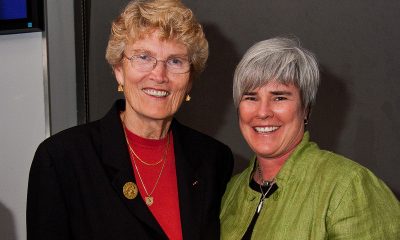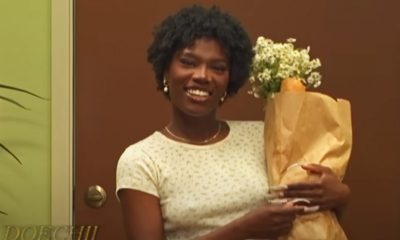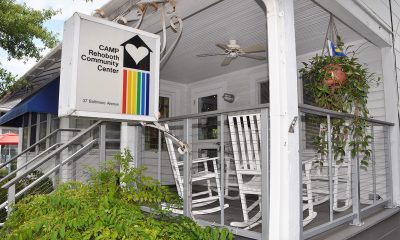a&e features
Singer/songwriter Janis Ian keeps it real in advance of April 28 D.C.-area show
‘At Seventeen’ Grammy winner weighs in on lesbian fans, soldiering on through adversity and more
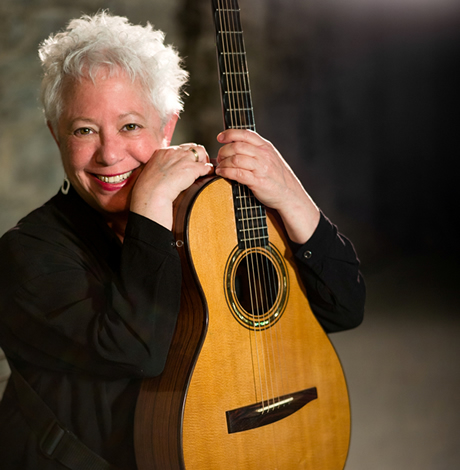
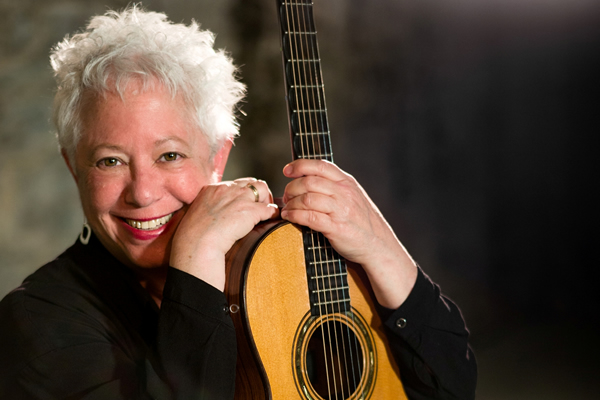
Janis Ian tells budding songwriters to study the classics and test your material on audiences who ‘couldn’t care less’ about you. (Photo by Lloyd Baggs; courtesy Ian)
Janis Ian
Saturday, April 28
The Birchmere
3701 Mount Vernon Ave.
Alexandria, Va.
7:30 p.m.
$45
birchmere.com
janisian.com
Janis Ian is having a rough weekend when we touch base April 13. The Grammy-winning singer/songwriter is soldiering on at CAMP Rehoboth Women’s Fest despite being dangerously close to having no singing voice.
She plays the Birchmere next weekend (April 28) and responded to these questions via e-mail, citing vocal preservation. Her comments have been slightly edited for length.
WASHINGTON BLADE: You’re playing CAMP Rehoboth Women’s Fest this weekend. What are the crowds like at these lesbian events? Have you done many of them?
IAN: It’s a lesbian event? (grin) I made a firm decision decades ago not to do any sort of exclusionary event, so the only “gay” events I’ve done have been Pride marches, or events like CAMP Rehoboth or the old Bloomington Women’s Music Festival (I think it has a new name now), both of which welcome all genders. As to the audiences, I’d say any time you have a festival-style event the crowds are going to be super enthusiastic because they’re there for more than just a few hours. They’re more relaxed and it’s a different excitement.
BLADE: How do you like performing at the Birchmere? Have you played there many times?
IAN: Hah! So many, I can’t even count, at the old and the new Birch. One of the best clubs in the world and I’ve played pretty much all of them. Not a bad seat in the house. I’ve even got Birchmere “war stories,” which I won’t go into here. Tom Paxton and I premiered our world tour there. I’ve premiered albums there. I can’t imagine life without it. Once I made the decision to stop touring very much, the first place to approach me was the Birchmere, via Mike Jaworek. I told him I wasn’t touring. He kept bothering me and bothering me and bothering me. I kept giving him reasons I couldn’t do it. He kept bothering me. He wore me down. Once I agreed, I got really excited. It’s like coming home and at 67, I have a perfectly good home in Tennessee already, thank you very much.
BLADE: What are the acoustics like at Carnegie Hall? Of course they’re legendary, but are they that much better than other great halls?
IAN: Yes. There’s the prestige of playing Carnegie, but there’s also the acoustics. Someone warned me about a “bass trap” in the upper left balcony before my first solo gig, so we faced the bass amp that way, and we were told it was the best sound from a band they’d ever heard. Most of the great halls were designed for non-amplified music — vaudeville halls. All the older, great Broadway halls. European halls and Carnegie. I think they’ve had to tear Philharmonic Hall apart now what — three times? — to fix the acoustics. Instead of relying on experience and ears, architectural firms and “soundscape engineers” (seriously? “soundcape engineer?”) rely on machines. Just stupid.
BLADE: Do you have Joan Baez’s new album? Any thoughts?
IAN: I do not have it yet, but my thoughts are that Joan has always been one of the kindest people on earth to me. I wish I had a song on it, but she’s done two of mine before and they’re among my proudest covers.
BLADE: How do you decide what key a song you’re writing is going to be in?
IAN: It feels right on my voice. Sometimes there’s a conflict — it might sound better in the studio a little higher or lower. Sometimes I have to change the guitar part to suit the key.
BLADE: When other artists have recorded your songs, do they often change the key?
IAN: Honestly, I have no idea. It never occurred to me to check.
BLADE: Back in the ‘60s/‘70s heyday of the big labels, did they let you have input into what your singles would be? Was there ever an instance where you were hoping it would be one song but the label was insisting on another?
IAN: I almost always had a good team around me, producer and A&R person, so I usually had input. I mean, no one wanted to put out a song the artist would refuse to sing on stage or TV, right? So fortunately for me, that’s never been a big issue. They’d have liked it if I’d written more commercial songs, but that’s not my gift.
BLADE: Amy Grant had a No. 1 hit with your song “What About the Love” in 1989. What are your memories of writing that song and do you have any idea how it got floated to a gospel artist?
IAN: I wrote it with Kye Fleming as we were sitting around her living room in Nashville, on the floor, just before Christmas I think. I was playing around with the guitar part, trying to put the first beat on the second note of the guitar pattern and making myself crazy trying to work it into my fingers. Then I began singing, “I went to see my sister. She was living with a friend …” and we were off and running. The minute we finished it, Kye said it had to go to Amy. I think Kye’s publisher must have done it, but she also knew Amy, so she may have pitched it herself. And Amy’s always said she’s a big fan of my work — she owns a hand-written copy of “At Seventeen,” for instance, so that may have helped get it in the door. Regardless, she’s a lovely woman and she did a great job.
BLADE: Have you ever demo’d it or performed it yourself?
IAN: It’s on the album “Breaking Silence.” Morgan Creek gave the rights back to me last year, so we’re in release now. In fact, I’ll be selling it at the Birchmere show because so many people have asked about it. Nice to have your first album after 10 years away become a Grammy nominee (she said musingly). It really is nice. It’s a fantastic audiophile recording; we’ve released it through Acoustic Sounds on vinyl, tape and SACD.
BLADE: Are you still friendly with Kye Fleming? About how many songs would you say you wrote together?
IAN: Yes, of course I’m still friendly with her. We lived together two-and-a-half years! We wrote 64 songs and among them are several of the absolute best songs I’ve ever been involved with. It’s a pity no one’s pushing them, because some are still un-recorded, but we did pretty well — Diane Schuur, Amy, Bette Midler, Charlie Daniels, Maura O’Connell, Cynthia Clawson, Marti Jones. It was an incredibly fertile period and I will always, always be grateful for it, and for Kye. I learned a ton about songwriting from her. She’s brilliant.
BLADE: Did you two have a private chuckle over a lesbian couple having penned a No. 1 song on the gospel music charts?
IAN: Probably not.
BLADE: Where did the material come from on your Unreleased collections? Are those alternate studio takes or songs you hadn’t previously recorded or both?
IAN: Both. I’ve spent the past 10 years plus having everything I’ve written and recorded transferred, updated, transferred, put on line. There are a lot of alt versions, though very few alt studio takes. A lot of demos and work tapes that haven’t, or have, been released.
BLADE: How long did it take you to write your memoirs?
IAN: I gave myself a year, because I’d never written anything that long before. I also researched and I had several fans who helped with research — dates, places, times and the like. It was good, because for a year I never set foot on a plane. I did four professional things — hosted a tribute to Odetta, sang at a tribute to Pete Seeger, played bass for Marie Knight and something else I can’t remember. They were all fun things to do, and they convinced me that it was more fun to do less, but do the things that brought me pleasure, than to do too much. I had time at home — long periods of time. I hadn’t had that since around 1991, so it was quite marvelous.
BLADE: What was your experience like working with John Mellencamp? What’s he like in the studio?
IAN: John was great. Very honest, very hard working, very respectful. You have to remember that at the time he brought me into the studio, no one in the music business gave a crap about me. I couldn’t get a publisher, a manager, a booking agent, record company — nothing and no one. John was the only professional in my field to put his money where his mouth was. I mean, it’s lovely to hear, “Oh, you’re a great writer, great performer, great singer,” but it’s not so great when they can’t make space for you at the table.
BLADE: What kind of feedback did you get as an Advocate columnist? Did you enjoy the gig?
IAN: I loved working with Judy Wieder, my editor there. I’d been turning her down for a year or so, and she suckered me into lunch with her and my wife when we were in L.A. I made the mistake of going to the rest room and while I was gone, they made the deal. I learned a ton that stood me in good stead when I wrote my autobiography. Having to come up with 1,000 words every month really teaches you a lot. As does having to be funny most of the time. So yes, I enjoyed it very much. I left when Judy was promoted and I had a new editor who didn’t see things the same way. When I began, I was literally hired to be the “resident iconoclast.” When I left, they had a lot of those. So it was time to go.
BLADE: What’s a songwriting trap you see beginning writers succumb to commonly?
IAN: Oh, gosh, there are so many. Settling. Being enthralled with yourself. Not knowing the basics. Is your second verse as strong as the first? Should your second verse be the first? Are you mixing metaphors? Are you saying that because it’s true, believable, what needs to be there, or are you saying it because it feels good on your voice? So, so many. I always tell people to play out and play out for people who don’t want to hear you. Don’t play for your friends and family — they’re obligated to like your work. Play for people who couldn’t care less. That’s part of how you learn. And remember the computer term GIGO — garbage in, garbage out. You listen to crap, you’ll write crap. Mostly, it’s the CD/technology issue. When you’re young, you don’t have much of a filter. You’re enthralled with your last song, because it’s astonishing and amazing and ennobling that you can even write a song. So, if you can make a CD for practically nothing, in practically no time, you end up putting all those songs on CDs. You make way too many CDs, too fast, and you think you’re growing, but you’re not. I had this discussion the other day with someone. When I started writing, none of us could afford songbooks. So we’d buy an album, listen to it, and write out the lyrics. Somehow, that connection from your hand to your brain teaches you. That’s what I’d tell young songwriters. Take a song you love by someone else. Listen to it and write out the lyrics. Once, twice, three times. Play it and sing it for a week. Get it into your body. Then move on to the next. Keep it different. Go from contemporary to Johnny Mercer. Don’t get tied down. And write them out.
BLADE: Did you have a noticeable lesbian fan base before you were outed or did that come later?
IAN: If you’re referring to the Village Voice piece by a writer who’s now dead, I can’t comment on that. I’d lived with a man, I then lived with a woman. I married a man, then married a woman. I identify as gay because that’s my tilt, but I wasn’t “known” as a gay woman until I chose to come out with it myself. I did it around the release of “Breaking Silence” because of a conversation I had with (longtime LGBT activist) Urvashi Vaid.
BLADE: You seem so at peace and pragmatic about life and the music business. Joni Mitchell has had almost a second career giving brutally candid interviews criticizing the music industry and calling it a cesspool. Do you applaud her candor or think she just sounds bitter and overly negative?
IAN: Joni also believes she was never paid enough and she has no musical equals. I don’t listen to it much.
BLADE: You’ve been through some scary times in the country with your father and the red scare. Are you fairly confident our national guardrails and checks and balances can withstand Trump? How closely are you following this?
IAN: We’re still an experiment; remains to be seen. I follow it as closely as everyone else and I wish people would listen to various news sources and go off line for a while.
BLADE: Will there be a new Janis Ian studio album of new material at some point?
IAN: Yes. It’s part of why I’m setting deadlines for my last touring days and my last album release. And a large part of why I’m touring so little.
BLADE: What would you guess is your ratio of released (you or other artists) vs. unreleased material of the songs you’ve written?
IAN: Not a clue.
BLADE: How regularly do you write these days?
IAN: Just depends on where I am and what I’m doing at the time.
BLADE: Was it ever hard to keep writing in leaner career periods?
IAN: Depending on the era, the assumption’s that if you’re not on TV, you’re dead. (Or your career is.) If you’re not on tour, you’re dead. (Or your career is.) If you’re not on Facebook, you’re dead. (Or your career is.) Artists don’t stop being artists. We don’t stop creating. Record companies stop wanting us. Promoters stop wanting us. Even audiences stop wanting us. But we don’t stop. That’s just not how it works.
a&e features
Tristan Schukraft on keeping queer spaces thriving
New owner of LA’s Abbey expands holdings to Fire Island, Mexico
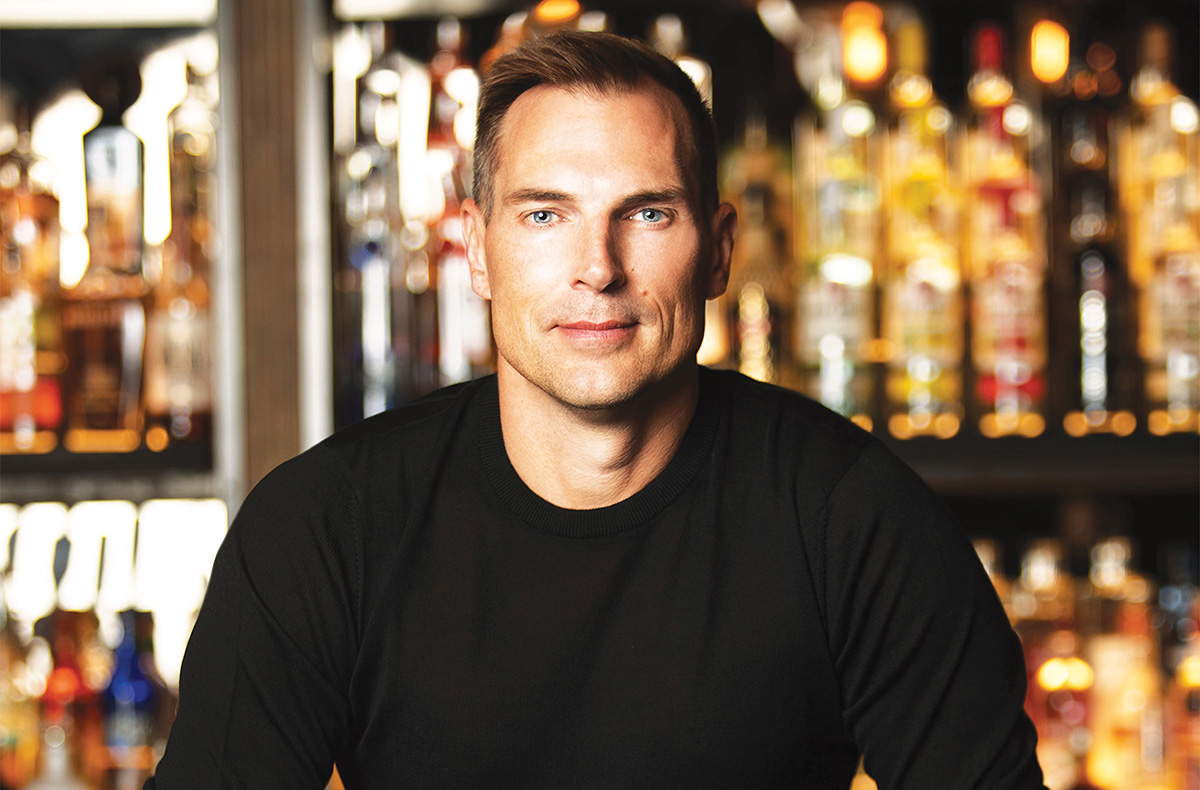
LOS ANGELES — Like the chatter about Willy Wonka and his Chocolate Factory, the West Hollywood community here started to whisper about the man who was going to be taking over the world-famous Abbey, a landmark in Los Angeles’s queer nightlife scene. Rumors were put to rest when it was announced that entrepreneur Tristan Schukraft would be taking over the legacy created by Abbey founder David Cooley. All eyes are on him.
For those of us who were there for the re-opening of The Abbey, when the torch was officially passed, all qualms about the new regime went away as it was clear the club was in good hands and that the spirit behind the Abbey would forge on. Cher, Ricky Martin, Bianca del Rio, Jean Smart, and many other celebrities rubbed shoulders with veteran patrons, and the evening was magical and a throwback to the nightclub atmosphere pre-COVID.
The much-talked-about purchase of the Abbey was just the beginning for Schukraft. It was also announced that this business impresario was set to purchase the commercial district of Fire Island, as well as projects launching in Mexico and Puerto Rico. What was he up to? Tristan sat down with the Blade to chat about it all.
“We’re at a time right now when the last generation of LGBT entrepreneurs and founders are all in their 60s and they’re retiring. And if somebody doesn’t come in and buy these places, we’re going to lose our queer spaces.”
Tristan wasn’t looking for more projects, but he recounts what happened in Puerto Rico. The Atlantic Beach Hotel was the gay destination spot and the place to party on Sundays, facing the gay beach. A new owner came in and made it a straight hotel, effectively taking away a place of fellowship and history for the queer community. Thankfully, the property is gay again, now branded as the Tryst and part of Schukraft’s portfolio with locations in Puerto Vallarta and Fire Island.
“If that happens with the Abbey and West Hollywood, it’s like Bloomingdale’s in a mall. It’s kind of like a domino effect. So that’s really what it is all about for me at this point. It has become a passion project, and I think now more than ever, it’s really important.”
Tristan is fortifying spaces for the queer community at a time when the current administration is trying to silence the LGBTQ+ community. The timing is not lost on him.
“I thought my mission was important before, and in the last couple of months, it’s become even more important. I don’t know why there’s this effort to erase us from public life, but we’ve always been here. We’re going to continue to be here, and it brings even more energy and motivation for me to make sure the spaces that I have now and even additional venues are protected going in the future.”
The gay community is not always welcoming to fresh faces and new ideas. Schukraft’s takeover of the Abbey and Fire Island has not come without criticism. Who is this man, and how dare he create a monopoly? As Schukraft knows, there will always be mean girls ready to talk. In his eyes, if someone can come in and preserve and advance spaces for the queer community, why would we oppose that?
“I think the community should be really appreciative. We, as a community, now, more than ever, should stand together in solidarity and not pick each other apart.”
As far as the Abbey is concerned, Schukraft is excited about the changes to come. Being a perfectionist, he wants everything to be aligned, clean, and streamlined. There will be changes made to the DJ and dance booth, making way for a long list of celebrity pop-ups and performances. But his promise to the community is that it will continue to be the place to be, a place for the community to come together, for at least another 33 years.
“We’re going to build on the Abbey’s rich heritage as not only a place to go at night and party but a place to go in the afternoon and have lunch. That’s what David Cooley did that no others did before, is he brought the gay bar outside, and I love that.”
Even with talk of a possible decline in West Hollywood’s nightlife, Schukraft maintains that though the industry may have its challenges, especially since COVID, the Abbey and nightlife will continue to thrive and grow.
“I’m really encouraged by all the new ownership in [nightlife] because we need another generation to continue on. I’d be more concerned if everybody was still in their sixties and not letting go.”
In his opinion, apps like Grindr have not killed nightlife.
“Sometimes you like to order out, and sometimes you like to go out, and sometimes you like to order in, right? There’s nothing that really replaces that real human interaction, and more importantly, as we know, a lot of times our family is our friends, they’re our adopted family.
Sometimes you meet them online, but you really meet them going out to bars and meeting like-minded people. At the Abbey, every now and then, there’s that person who’s kind of building up that courage to go inside and has no wingman, doesn’t have any gay friends. So it’s really important that these spaces are fun, to eat, drink, and party. But they’re really important for the next generation to find their true identity and their new family.”
There has also been criticism that West Hollywood has become elitist and not accessible to everyone in the community. Schukraft believes otherwise. West Hollywood is a varied part of queer nightlife as a whole.
“West Hollywood used to be the only gay neighborhood, and now you’ve got Silver Lake and you’ve got parts of Downtown, which is really good because L.A., is a huge place. It’s nice to have different neighborhoods, and each offers its own flavor and personality.”
Staunch in his belief in his many projects, he is not afraid to talk about hot topics in the community, especially as they pertain to the Abbey. As anyone who goes to the Abbey on a busy night can attest to, the crowd is very diverse and inclusive. Some in the community have started to complain that gay bars are no longer for the gay community, but are succumbing to our straight visitors.
Schukraft explains: “We’re a victim of our own success. I think it’s great that we don’t need to hide in the dark shadows or in a hole-in-the-wall gay bar. I’m happy about the acceptance. I started Tryst Hotels, which is the first gay hotel. We’re not hetero-friendly, we’re not gay-friendly. We’re a gay hotel and everyone is welcome. I think as long as we don’t change our behavior or the environment in general at the Abbey, and if you want to party with us, the more than merrier.”
Schukraft’s message to the community?
“These are kind of dangerous times, right? The rights that we fought for are being taken away and are being challenged. We’re trying to be erased from public life. There could be mean girls, but we, as a community, need to stick together and unite, and make sure those protections and our identity aren’t erased. And even though you’re having a drink at a gay bar, and it seems insignificant, you’re supporting gay businesses and places for the next generation.”
a&e features
Creator Max Mutchnick on inspirations for ‘Mid-Century Modern’
Real-life friendships and loss inform plot of new Hulu show
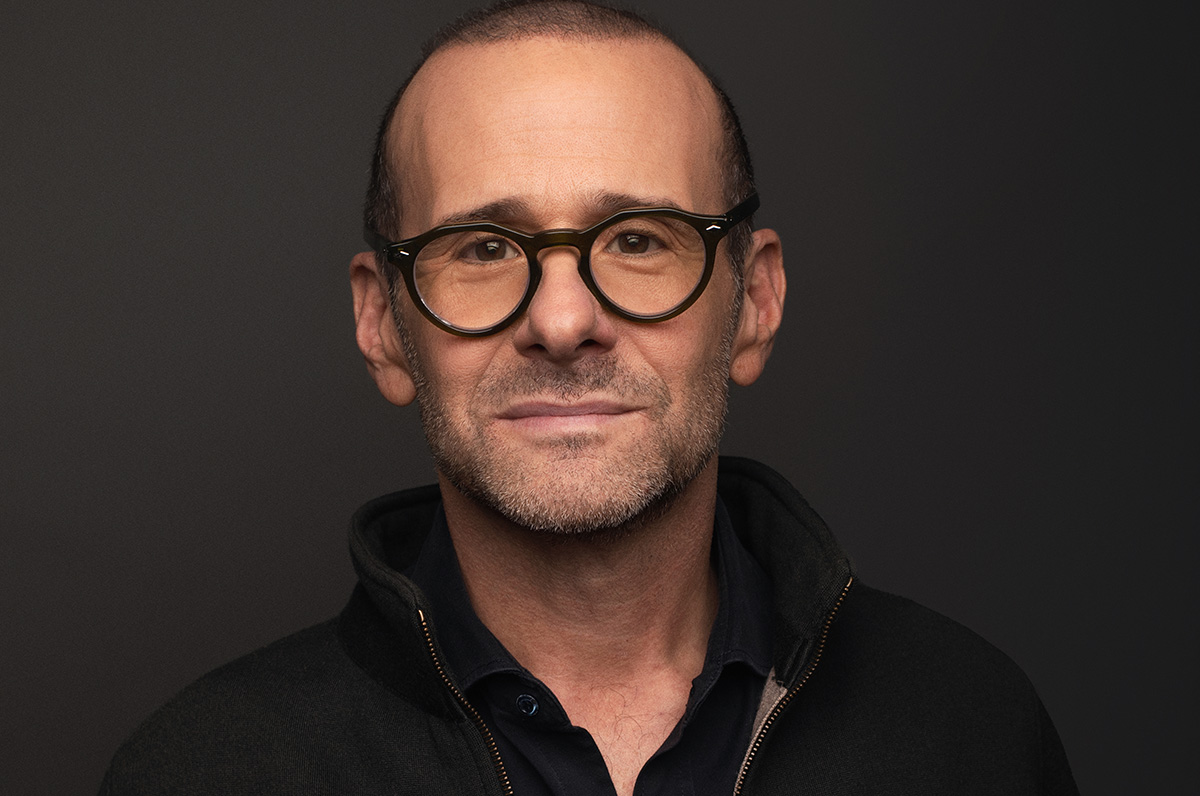
It’s been a long time – maybe 25 years when “Will & Grace” debuted – since there’s been so much excitement about a new, queer sitcom premiering. “Mid-Century Modern,” which debuted on Hulu last week, is the creation of Max Mutchnick and David Kohan, the gay men who were also behind “Will & Grace.”
Set in Palm Springs, Calif., following the death of the one of their closest friends, three gay men gather to mourn. Swept up in the emotions of the moment, Bunny (Nathan Lane) suggests that Atlanta-based flight attendant Jerry (Matt Bomer) and New York-based fashion editor Arthur (Nathan Lee Graham) move into the mid-century modern home he shares with his mother Sybil (the late Linda Lavin). Over the course of the first season’s 10 episodes, hilarity ensues. That is, except for the episode in which they address Sybil’s passing. The three male leads are all fabulous, and the ensemble cast, including Pamela Adlon as Bunny’s sister Mindy, and the stellar line-up of guest stars, such as Jesse Tyler Ferguson, Vanessa Bayer, Richard Kind, and Cheri Oteri, keep humor buzzing. Shortly before the premiere of “Mid-Century Modern,” Mutchnick made time for an interview with the Blade.
BLADE: I’d like to begin by saying it’s always a delight to speak to a fellow Emerson College alum. In ways would you say that Emerson impacted your professional and creative life?
MAX MUTCHNICK: I think Emerson was the first place that reflected back to me that my voice, my thoughts were good, and they were worth listening to. I developed a confidence at Emerson that did not exist in my body and soul. It was a collection of a lot of things that took place in Boston, but I mean we can just put it all under the Emerson umbrella.
BLADE: Before “Will & Grace,” you co-created the NBC sitcom “Boston Common,” which starred fellow Emerson alum Anthony Clark. Is it important for you to maintain those kinds of alumni relationships?
MUTCHNICK: Because Emersonians are such scrappy little monkeys and they end up being everywhere in the world, you can’t help but work with someone from Emerson at some point in your career. I’m certainly more inclined to engage with someone from Emerson once I learn that they went to my alma mater. For me, it has much more to do with history and loyalty. I don’t think of myself as one of those guys that says, “Loyalty means a lot to me. I’m someone that really leans into history.” It’s just what my life and career turned out to be. The longer I worked with people and the more often I worked with them, the safer that I felt, which means that I was more creative and that’s the name of the game. I’ve got to be as comfortable as possible so I can be as creative as possible. If that means that a person from Emerson is in the room, so be it. (Costume designer) Lori Eskowitz would be the Emerson version. And then (writer and actor) Dan Bucatinsky would be another version. When I’m around them for a long time, that’s when the best stuff comes.
BLADE: Relationships are important. On that subject, your new Hulu sitcom “Mid-Century Modern” is about the longstanding friendship among three friends, Bunny (Nathan Lane), Jerry (Matt Bomer), and Arthur (Nathan Lee Graham). Do you have a friendship like the one shared by these three men?
MUTCHNICK: I’m absolutely engaged in a real version of what we’re projecting on the show. I have that in my life. I cannot say that I’m Jerry in any way, but the one thing that we do have in common is that in my group, I’m the young one. But I think that that’s very common in these families that we create. There’s usually a young one. Our culture is built on learning from our elders. I didn’t have a father growing up, so maybe that made me that much more inclined to seek out older, wiser, funnier, meaner friends. I mean the reason why you’re looking at a mouthful of straight, white teeth is because one of those old bitches sat across from me about 25 years ago at a diner and said, “Girl, your teeth are a disaster, and you need to get that fixed immediately.” What did I know? I was just a kid from Chicago with two nickels in my pocket. But I found three nickels and I went and had new teeth put in my head. But that came from one of my dearest in the group.
BLADE: Do you think that calling “Mid-Century Modern” a gay “Golden Girls” is a fair description?
MUTCHNICK: No. I think the gay “Golden Girls” was really just used as a tool to pitch the show quickly. We have an expression in town, which is “give me the elevator pitch,” because nobody has an attention span. The fastest way you can tell someone what David (Kohan) and I wanted to write, was to say, “It’s gay Golden Girls.” When you say that to somebody, then they say, “OK, sit down now, tell me more.” We did that and then we started to dive into the show and realized pretty quickly that it’s not the gay “Golden Girls.” No disrespect to the “Golden Girls.” It’s a masterpiece.
BLADE: “Mid-Century Modern” is set in Palm Springs. I’m based in Fort Lauderdale, a few blocks south of Wilton Manors, and I was wondering if that gay enclave was ever in consideration for the setting, or was it always going to be in Palm Springs?
MUTCHNICK: You just asked a really incredible question! Because, during COVID, Matt Bomer and I used to walk, because we live close by. We had a little walking group of a few gay gentlemen. On one of those walks, Matt proposed a comedy set in Wilton Manors. He said it would be great to title the show “Wilton Manors.” I will tell you that in the building blocks of what got us to “Mid-Century Modern,” Wilton Manors, and that suggestion from Matt Bomer on our COVID walks, was part of it.
BLADE: Is Sybil, played by the late Linda Lavin, modeled after a mother you know?
MUTCHNICK: Rhea Kohan (mother of David and Jenji). When we met with Linda for the first time over Zoom, when she was abroad, David and I explained to her that this was all based on Rhea Kohan. In fact, some of the lines that she (Sybil) speaks in the pilot are the words that Jenji Kohan spoke about her mother in her eulogy at the funeral because it really summed up what the character was all about. Yes, it’s very much based on someone.
BLADE: The Donny Osmond jokes in the second episode of “Mid-Century Modern” reminded me of the Barry Manilow “fanilows” on “Will & Grace.” Do you know if Donny is aware that he’s featured in the show?
MUTCHNICK: I don’t. To tell you the truth, the “fanilow” episode was written when I was not on the show. I was on a forced hiatus, thanks to Jeff Zucker. That was a show that I was not part of. We don’t really work that way. The Donny Osmond thing came more from Matt’s character being a Mormon, and also one of the writers. It’s very important to mention that the writing room at “Mid-Century Modern,” is (made up of) wonderful and diverse and colorful incredible humans – one of them is an old, white, Irish guy named Don Roos who’s brilliant…
BLADE: …he’s Dan Bucatinsky’s husband.
MUTCHNICK: Right! Dan is also part of the writing room. But I believe it was Don who had a thing for Donny, and that’s where it comes from. I don’t know if Donny has any awareness. The only thing I care about when we turn in an episode like that is I just want to hear from legal that we’re approved.
BLADE: “Mid-Century Modern” also includes opportunities for the singers in the cast. Linda Lavin sang the Jerome Kern/Ira Gershwin tune “Long Ago (And Far Away)” and Nathan Lane and the guys sang “He Had It Coming” from “Chicago.” Was it important to give them the chance to exercise those muscles?
MUTCHNICK: I don’t think it was. I think it really is just the managers’ choice. David Kohan and I like that kind of stuff, so we write that kind of stuff. But by no means was there an edict to write that. We know what our cast is capable of, and we will absolutely exploit that if we’re lucky enough to have a second season. I have a funky relationship with the song “Long Ago (And Far Away).” It doesn’t float my boat, but everybody else loved it. We run a meritocracy, and the best idea will out. That’s how that song ended up being in the show. I far prefer the recording of Linda singing “I’ll Be Seeing You” over her montage in episode eight, “Here’s To You, Mrs. Schneiderman.” We were just lucky that Linda had recorded that. That recording was something that she had done and sent to somebody during COVID because she was held up in her apartment. That’s what motivated her to make that video and send it. That’s how we were able to use that audio.
BLADE: Being on a streaming service like Hulu allows for characters to say things they might not get away with on network TV, including a foreskin joke, as well as Sybil’s propensity for cursing.
MUTCHNICK: And the third line in the show is about him looking like a “reluctant bottom.” I don’t think that’s something you’re going to see on ABC anytime soon. David and I liked the opportunity to open up the language of this show because it might possibly open the door to bringing people…I’m going to mix metaphors…into the tent that have never been there before. A generation that writes off a sitcom because that language and that type of comedy isn’t the way that they sound. One of the gifts of doing this show on Hulu is that we get to write dialogue that sounds a little bit more like you and I sound. As always, we don’t want to do anything just to do it.
BLADE: It didn’t feel that way.
MUTCHNICK: It’s there when it’s right. [Laughs] I want to have a shirt made with Linda’s line, as her mother always used to say, “Time is a cunt.”
BLADE: “Mid-Century Modern” also utilizes a lot of Jewish humor. How important is it for you to include that at this time when there is a measurable rise in anti-Semitism?
MUTCHNICK: I think it’s important, but I don’t think it’s the reason why we did it. We tried very hard to not write from a place of teaching or preaching. We really are just writing about the stuff that makes us laugh. One of the things that makes something better and something that you can invest in is if it’s more specific. We’re creating a character whose name is Bunny Schneiderman and his mother’s name is Sybil and they made their money in a family-run business, it gets Jewy, and we’re not going to shy away from it. But we’re definitely not going to address what’s going on in the world. That doesn’t mean I don’t find it very upsetting, but I’m writing always from the point of view of entertaining the largest number of people that I can every week.
BLADE: “Mid-Century Modern” has a fantastic roster of guest stars including Jesse Tyler Ferguson, Vanessa Bayer, Billie Lourd, Cheri Oteri, Richard Kind, Rhea Perlman, and Judd Hirsch. Are there plans to continue that in future seasons?
MUTCHNICK: Yes. As I keep saying, if we’re so lucky that we get to continue, I don’t want to do “The Love Boat.” Those are fine comic actors, so I don’t think it feels like that. But if we get to keep going, what I want to do is broaden the world because that gives us more to write about. I want to start to introduce characters that are auxiliary to the individuals. I want to start to meet Arthur’s family, so we can return to people. I want to introduce other neighbors, and different types of gay men because we come in so many different flavors. I think that we should do that only because I’m sure it’s what your life is and it’s what my life is. I’ve got a lot of different types. So, yes, we will be doing more.
BLADE: Finally, Linda Lavin passed away in December 2024, and in a later episode, the subject of her character Sybil’s passing is handled sensitively, including the humorous parts.
MUTCHNICK: We knew we had a tall order. We suffered an incredible loss in the middle of making this comedy. One of the reasons why I think this show works is because we are surrounded by a lot of really talented people. Jim Burrows and Ryan Murphy, to name two. Ryan played a very big role in telling us that it was important that we address this, that we address it immediately. That we show the world and the show goes on. That wasn’t my instinct because I was so inside the grief of losing a friend, because she really was. It wasn’t like one of those showbizzy-type relationships. And this is who she was, by the way, to everybody at the show. It was the way that we decided to go. Let’s write this now. Let’s not put this at the end of the season. Let’s not satellite her in. Let’s not “Darren Stevens” the character, which is something we would never do. The other thing that Jim Burrows made very clear to us was the import of the comedy. You have to write something that starts exactly in the place that these shows start. A set comedy piece that takes place in the kitchen. Because for David and me, as writers, we said we just want to tell the truth. That’s what we want to do with this episode and that’s the way that this will probably go best for us. The way that we’ve dealt with grief in our lives is with humor. That is the way that we framed writing this episode. We wanted it to be a chapter from our lives, and how we experience this loss and how we recover and move on.
a&e features
Margaret Cho returns to music with ‘Lucky Gift’
Collection of pop tunes includes tribute to non-binary people
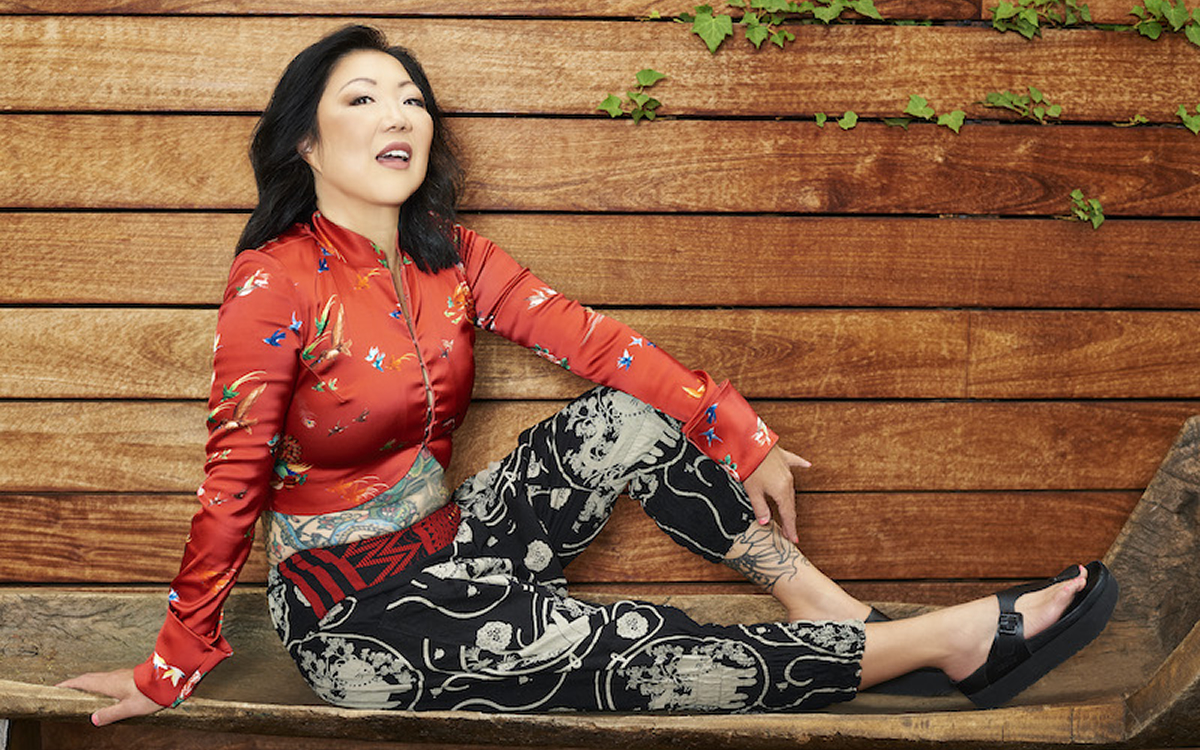
LOS ANGELES — It has been eight years since Margaret Cho released her Grammy-nominated “American Myth” album. She’s back to the music scene with her new album, “Lucky Gift,” an 11-track collection of anthems and pop tunes, a tribute to Robin Williams, and a shout-out to non-binary and gender non-conforming people.
The album captures the whirlwind that is Margaret and all of the different facets of her talents that have made her a powerhouse in entertainment and a leader in activism. In “Lucky Gift,” she’s getting her point across while having fun and getting glam.
We caught up with the activist and artist to chat about her music, our political climate, and the power of pop divas.
Known for her comedy, acting, and activism, she felt it was long overdue to get her music back out there too.
“I make music often. It’s a part of my daily life, it’s a big part of my social life, and it’s just something that I just love to do for my own relaxation and fun. I had enough for an album and I wanted to finally put them out. I was just really proud of how it all sounded together,” shares Cho.
“It’s a power pop record. For me, the songs are really meaningful. They’re all in their own way love songs. I’m a big fan of my own music (laughs), I really like the way that I sound and it’s really special to do. People know me as a comedian, and I have also made music for a long time, but it’s sort of a side project, and so it was time to put more out again.”
Her album also includes a touching tribute to Robin Williams. The entertainment community is finally more comfortable talking about mental health more openly. When relating mental health to her own life, Margaret, in true Margaret form, quickly turned the conversation to reflect today’s political climate.
“I have to maintain a level of peace and quiet and sometimes maybe get away from the news, although that’s tough because I am obsessed. I want to know what is happening. I’m really worried for our community, especially the trans community. I’m worried that this administration is trying to separate T and the Q from the LGBTQIA, and it’s really frightening.”
As an elder, Cho says she has to also remember that we’ve been through this before and it’s actually been much worse. As a community, we’ve been through a similar situation, and we were facing down a pandemic, which was killing us by the millions. So at least now we don’t have to fight AIDS as well as this onslaught of homophobia.
“We have fought for our rights, and we still have them, but we may not have them for long. So our mental health is very important to preserve now because we have to fight. The one thing to remember is they can’t do everything at once. They can’t take away trans rights, queer rights, gay rights, gay marriage, anti-depressants —ha — at the same time. So what we can do is just try to remain as calm as possible and fight as strongly as we can. But yeah, mental health is really vitally important right now.”
Margaret’s long history of queer activism stands for itself. She does not shy away from current issues, she uses her platforms to incite, educate, and question. For Margaret, there is no time off from being an activist. She was born into it, so to speak, being raised in San Francisco in the 1970s, her parents — the owners of a gay bookstore — and their employees followers of Harvey Milk.
“My activism is that I don’t have a choice. I’m going to be an activist no matter what. We’re doing this together, we’re going through this together. I will always be political. It’s just disheartening to see the ignorance of people and the lies that are being told that are believed.”
Margaret’s “Lucky Gift” comes at a perfect time when the queer community can come together over music. Cho looks at her album as a tool to empower an underdog community through the power of music.
“It’s the triumph of pop above all. We need to look to our pop divas above all. So now I’m more than ever, leaning on Madonna. [Thank God for Lady Gaga’s] “Abracadabra” because I think that things like that boost our community so much. When you can just get together and have a “brat summer,” that boosts our community so much in this togetherness, this explosion of excitement. I think Chappell Roan really ignited the pop capacity for healing. I love ‘Lucky Gift’ because it is my stepping into a pop diva moment. Pop divas should not be discounted for how important they are to our society and how much they lift us up.”
In addition to releasing her new album, Cho will continue to hit the road this year with her “Live and LIVID! Tour,” celebrating more than four decades of live stand-up shows. On this tour, she promises to rage about homophobia, sexism, racism, and the fight to stay alive. The five-time Grammy and Emmy-nominated performer is not holding back. According to her, the nation is not divided, just a little lost.
“We’re not divided. Everybody hates this. We all hate this. The fact is, the majority of the country does not want this. Unfortunately, a lot of people just didn’t vote because they just didn’t want to participate. That’s why we’re in the situation that we’re in. So to be on the road is a pleasure. And I rarely come against opposition. Every once in a while there’s something, but it’s something that we all handle. I think we all need a voice, a strong voice of reason to combat all of the hysteria.”
And her message to her fans?
“We’ll get through this. We’ll get through this with pop divas. ‘Abracadabra,’ learn the choreography, you do it sitting down. At least we have pop music, I have my hat in the ring here. But at least we have each other and we’re going to be OK. It’s going to be a ride, it’s going to be intense, but we can do this. We’ve been through this before and we are going to be fine.”
“Lucky Gift”is now available on all major streaming platforms.
-

 Opinions5 days ago
Opinions5 days agoIt’s time for new leadership on the Maryland LGBTQIA+ Commission
-

 The White House5 days ago
The White House5 days agoWhite House does not ‘respond’ to reporters’ requests with pronouns included
-
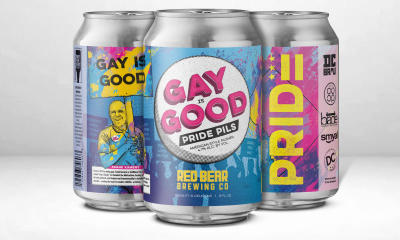
 Arts & Entertainment5 days ago
Arts & Entertainment5 days ago‘Gay is Good’ Pride Pils Can Celebrates Frank Kameny’s 100th Birthday for WorldPride in D.C.
-

 Sponsored5 days ago
Sponsored5 days agoTHC Drinks: What You Should Know About Cannabis Beverages

